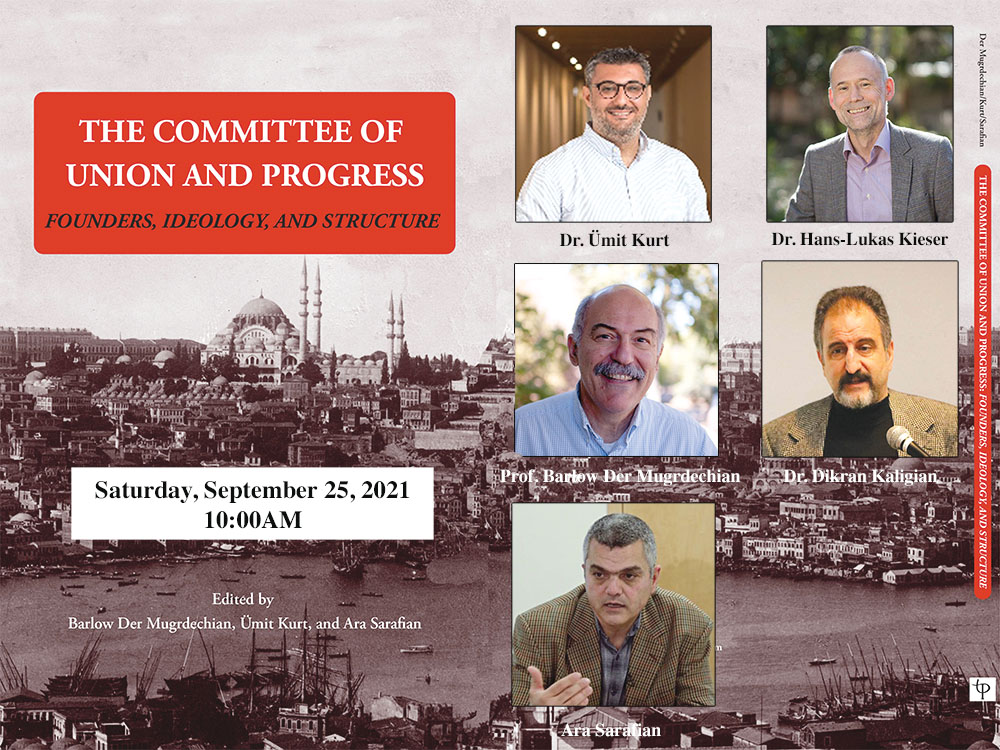
Christine Pambukyan
Staff Writer
“It is a fresh and healthy approach to modern Armenian and historical Armenian studies that is much more inclusive of the broader context in which Armenian history exists,” said Ara Sarafian, one of three co-editors of The Committee of Union and Progress: Founders, Ideology and Structure.
A panel discussion was held on Saturday, September 25, to mark the publication of a new book, The Committee of Union and Progress: Founders, Ideology and Structure, volume 13 in Armenian Series of The Press at California State University, Fresno.
Three of the contributors and the co-editors of the newly published book gave an overview of the chapters they each contributed and also gave an overall perspective of the significance of the new volume.
The book, was the product of an October, 2018 conference, “The Committee of Union and Progress: Founders, Ideology, and Structure” organized by Prof. Barlow Der Mugrdechian and Dr. Ümit Kurt. The intent of the conference was to bring new light to the topic of the Committee of Union and Progress (CUP), the leading political party in power in Turkey from 1908 to the end of World War I. The panelists discussed the Ottoman Armenians and the Turkish National Movement, and gave new insights on the Armenian Genocide. The articles presented during this conference were edited and consolidated into a single volume, composed of five chapters.
Dr. Ümit Kurt, a Polansky Fellow at the Van Leer Jerusalem Institute, opened the discussion with an overview about his chapter titled, “The Post-Revolutionary Period in Aintab and the Curious Case of Necmeddin Bey.” He discussed the repercussions of the July 1908 Ottoman revolution in Aintab and the socioeconomic climate in the city. The “revolution led to serious changes in the dynamics of power relations in different religious communities of the Ottoman Empire… for the Armenians, a rebirth and new age had begun in the city,” emphasized Dr. Kurt. After the beating of Necmeddin Bey, protesters demanded new leadership with a different district governor. “Any insult or assault on this person was taken as an attack on the central government and state itself, as Necmeddin Bey was a representative of the state and government regardless of his political views” stated Dr. Kurt. This incident illustrated the complex changes instituted during the period of the CUP and their impact on the Christians in the Empire.
Dr. Hans-Lukas Kieser, of the University of Newcastle, discussed his chapter titled “Ziya Gökalp, Duumvir.” Dr. Kieser discussed the relationship between CUP Central committee member Talaat Pasha and Gökalp, who worked together and used their power and influence on their followers in the CUP to achieve their goals. “It was on Gokalp’s advice, that hand in hand with the Armenian Genocide, the Interior Ministry’s directorate of the settlement of refugees and tribes undertook ethnographic sociological investigations in order to prepare a Turkification of Anatolia,” said Dr. Kieser.
Dr. Dikran Kaligian then discussed his chapter “When Revolutionaries Must Govern: The Vicissitudes of ARF-CUP Relations.” Within his chapter, Dr. Kaligian discusses the “ups and downs” of the relationship between the Armenian Revolutionary Federation (ARF) and the CUP. “All of the official papers of the CUP at the end of World War I mysteriously, or perhaps conveniently, dis-appeared,” stated Dr. Kaligian. Due to this fact, Dr. Kaligian used the archives of the ARF, which was the leading Armenian political party and closest ally to the CUP in the period.
The ARF worked with the CUP after the 1908 revolution to gain rights and power for Armenians. The CUP was “depending on the expertise of the better educated non-Muslim groups to further their own program of reform and progress,” explained Dr. Kaligian. On the other hand, the ARF worked with the CUP to achieve the goal of regaining lost Armenian historical lands and to achieve their promised equality as Ottoman citizens. Unfortunately, “Talaat would not take the decisive step regarding the land issue,” said Dr. Kaligian, especially because the Kurds and the Muslims were pushing against the pro-Armenian reforms in order to not lose their power.
In 1914, on the eve of World War I, two CUP representatives attended the ARF World Congress in Erzerum, and tried to convince the Armenians to enlist support from the Armenians in Russia. The ARF warned the Young Turks to not join the war as it would result in the defeat of the Ottoman Empire, thus bringing an end to the rocky relationship between the ARF and the CUP.
Co-editor and director of the London-based Gomidas Institute, Ara Sarafian summarized the discussion and presented his thoughts about the publication. “The denial process is part of the problem because the work we are doing not only has academic merit or historiographical significance, but it also has a political significance,” emphasized Sarafian.
Sarafian strongly encouraged the research and publication of Armenian historical events in a broader context with a different perspective. This new publication is “re-configuring and reformatting Armenian Studies,” concluded Sarafian.
The lecture is archived on the Armenian Studies YouTube Channel at https://bit.ly/armenianstudiesyoutube.
The book is available for purchase through Abril Books at http://www.abrilbooks.com/books/committee-of-union-and-progress-the.html and NAASR Bookstore at https://naasr.org/products/committee-of-union-and-progress-the-founders-ideology-and-structure.
 Hye Sharzhoom Armenian Action
Hye Sharzhoom Armenian Action